
Highlights of Current Research on Leukemia, MDS, and Allotransplant
Key Takeaways
- Ivosidenib and venetoclax, with azacitidine, showed enhanced efficacy in IDH1-mutated AML, warranting further investigation into response duration and biomarkers.
- The OPTIC trial identified a ponatinib dosing regimen for CP-CML, optimizing efficacy and safety with a reduced arterial occlusive event rate.
At the 2020 ASCO Annual Meeting, speaker Leslie R. Ellis, MD, MSHPEd, FACP, discussed the results of studies in a session looking into current research on leukemia, MDS, and allotransplant.
At the virtual scientific program of the 2020 American Society of Clinical Oncology (ASCO) Annual Meeting, speaker Leslie R. Ellis, MD, MSHPEd, FACP, associate professor of medicine, Wake Forest Baptist Health, Comprehensive Cancer Center Winston-Salem, discussed the results of studies in a session looking into current research on leukemia, myelodysplastic syndromes (MDS), and allotransplant.1
Study of the IDH1-Mutant Inhibitor Ivosidenib (AG120) With the BCL2 Inhibitor Venetoclax
The first study discussed was the phase 1b/2 trial looking into the adverse effects and dosing of venetoclax when paired with ivosidenib, with or without being paired with azacitidine additionally. These treatments were used with participants in the study who had IDH1-mutated hematologic malignancies.1,2
The results demonstrated that venetoclax and ivosidenib may stop cancer cell growth by blocking some of the enzymes necessary for cell growth. In chemotherapy, drugs such as azacytidine work differently by hindering growth of cancer cells through either killing the cells, stopping them from dividing, or stopping them from spreading.1,2
The researchers found that treatment with ivosidenib and venetoclax with azacitidine may be more effective when treating patients with IDH1-mutated AML, compared with ivosidenib and venetoclax alone. Ellis added that the results demonstrated that further follow up and accrual would be ongoing in order to better define the duration and biomarkers of response in patients.1,2
OPTIC Study of Ponatinib for Chronic Phase-CML
The second study discussed in the session was the phase 2 OPTIC (Optimizing Ponatinib Treatment In CML) trial evaluating response-based dosing regimens of ponatinib over a range of 3 starting doses (45 mg, 30 mg, 15 mg).1,3
The aim of the study was to optimize the treatment’s efficacy and safety in patients with chronic-phase chronic myeloid leukemia (CP-CML) who were found to be resistant or intolerant to tyrosine kinase inhibitor therapy.1,3
With median follow-up time of approximately 21 months, data from the interim analysis demonstrated that the optimal benefit-risk profile for ponatinib in patients with CP-CML was observed at a daily starting dose of 45 mg followed by a reduction to 15 mg after achieving ≤1% BCR-ABL1. Following this dose reduction to 15 mg/day, the optimal benefit to treatment was demonstrated to be maintained by patients. This dosing regimen was also found to result in an adjudicated arterial occlusive event rate of 5.3%.1,3
Ellis explained that the complete primary analysis of the trial will occur after all patients are able to have at least 12 months of follow-up, with the resulting data being presented following this occurrence.1,3
Pediatric Disease Risk Index for Allogeneic Stem Cell Transplantation
In the final study discussed during the session, Ellis presented a recently developed validated pediatric disease risk index (p-DRI) for acute myeloid (AML) and acute lymphoblastic leukemia (ALL) that provides a stratification of children receiving allogeneic hematopoietic cell transplantation for prognostication.1,4
Characteristics such as disease, disease status, and cytogenetic abnormalities are known to effect relapse and survival in patients following transplantation for AML and ALL. It has previously been observed in adults that these attributes can be used to develop a disease risk index for survival. For this reason, the analysis conducted was aimed to develop and validate a p-DRI.1,4
Patients who were younger than 18 years with AML and ALL transplanted between 2008 and 2017 in the United States were eligible for the p-DRI, with separate analyses performed for both AML and ALL. Each patient was randomly assigned to a training and validation cohort.1,4
In order to select significant variables, the researchers used the Cox proportional hazards model with stepwise selection. The primary outcome was leukemia-free survival (LFS).1,4
There were 4 risk groups identified for AML and 3 risk groups for ALL. The probabilities over 5 years of LFS for AML were 81%, 56%, 44%, and 21% for good, intermediate, high, and very high-risk groups, respectively. For ALL, the probabilities over 5 years of LFS for ALL were 68%, 50%, and 15% for good, intermediate, high risk groups, respectively.1,4
Ellis explained that based on these results, the researchers were able to validate that the p-DRI effectively stratified children with AML and ALL for prognostication undergoing allogeneic transplantation.1,4
REFERENCES
- Ellis L. Hematologic Malignancies - Leukemia, MDS, and Allotransplant. Presented at: 2020 American Society of Clinical Oncology (ASCO) Annual Meeting; 2020; virtual. meetinglibrary.asco.org/record/191625/video Accessed June 3, 2020.
- Lachowiez CA, Borthakur G, Loghavi S, et al. Phase Ib/II study of the IDH1-mutant inhibitor ivosidenib with the BCL2 inhibitor venetoclax +/- azacitidine in IDH1-mutated hematologic malignancies. Journal of Clinical Oncology. 2020;38(15_suppl): 7500-7500. doi: 10.1200/JCO.2020.38.15_suppl.7500
- Cortes JE, Lomaia E, Turkina A, et al. Interim analysis (IA) of OPTIC: A dose-ranging study of three ponatinib (PON) starting doses. Journal of Clinical Oncology. 2020;38(15_suppl): 7502-7502. doi: 10.1200/JCO.2020.38.15_suppl.7502.
- Qayed M, Kitko CL, Ahn KW, et al. Development and validation of a pediatric disease risk index for allogeneic hematopoietic cell transplantation. Journal of Clinical Oncology. 2020;38(15_suppl): 7503-7503. doi: 10.1200/JCO.2020.38.15_suppl.7503.
Newsletter
Stay informed on drug updates, treatment guidelines, and pharmacy practice trends—subscribe to Pharmacy Times for weekly clinical insights.
















































































































































































































